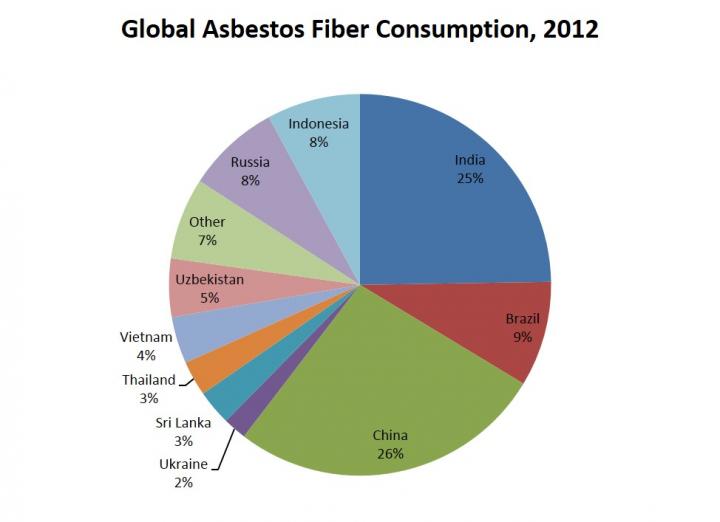Asbestos: An ongoing challenge to global health

This is a pie chart of global asbestos fiber consumption in 2012. Credit: International Ban Asbestos Secretariat & Citi Research
Challenges to global health can evolve from policies and decisions that take years or decades to unfold. An article in the current issue of the Annals of Global Health describes the current state of asbestos use worldwide, a story that began over 100 years ago, and the real and contrived controversies regarding asbestos.
At the peak of asbestos use in 1972 in the United States, more than 775,000 tons of asbestos were used, much of it by the construction trades and shipbuilding industry, in addition to the manufacturing of many consumer products. As the health risks associated with asbestos have become evident, more than 50 countries have banned asbestos, although India and the United States have not.
As investigators Arthur L. Frank, MD, PhD, Drexel University School of Public Health, Philadelphia, Pennsylvania, USA, and T.K. Joshi, MBBS, MS (Surgery), Centre for Occupational and Environmental Health, Maulana Azad Medical College, New Delhi, India, relate, “Unfortunately, as the developed world was banning or constricting the use of asbestos, the developing world was greatly increasing its use of this toxic material.
Major producers such as Russia, Kazakhstan, China, and Brazil continue to produce and export asbestos to countries around the world, especially to low- and middle-income countries that too often have weak or nonexistent occupational and environmental regulations.” They note that India produces little asbestos, but has become a major importer with exponential growth in manufacture of asbestos cement and pipes.
Asbestos minerals are divided into two groups, amphibole and serpentine, based on their chemistry and fiber morphology. The amphibole group includes crocidolite, amosite, tremolite, actinolite, and anthophyllite asbestos. The serpentine group is comprised solely of chrysotile asbestos, and it accounts for some 90% to 95% of all the asbestos used worldwide.
Two groups of diseases are associated with exposures to asbestos: nonmalignant diseases, which can be fatal, and cancer. The nonmalignant diseases associated with exposure to asbestos include asbestos warts, benign asbestotic pleural effusion, and asbestosis.
The now disproven belief that chrysotile asbestos is safe and the actions of the governments of Canada and India to support asbestos production in the face of strong epidemiological data show that this is not a strictly science-driven issue. Canada has recently had a turnabout and will likely exit the asbestos business, but India remains recalcitrant.
Dr. Frank and Dr. Joshi report on how the global spread of asbestos is changing but that there are still examples of flawed science being used to justify continued use. They suggest that, because of economic issues for asbestos producers, there “are far more insidious actions that follow a pattern first established by the tobacco industry in hiring public relations firms to obfuscate the scientific issues so that tobacco could still be sold…Similarly, the asbestos industry adopted the view that a public relations campaign was needed to quash the rising concerns about its health hazards.”
The authors caution that eventually the truths regarding asbestos exposure and its true hazards will be recognized and acted upon, but only after economic forces are overcome.
Media Contact
More Information:
http://www.elsevierhealth.com/All latest news from the category: Health and Medicine
This subject area encompasses research and studies in the field of human medicine.
Among the wide-ranging list of topics covered here are anesthesiology, anatomy, surgery, human genetics, hygiene and environmental medicine, internal medicine, neurology, pharmacology, physiology, urology and dental medicine.
Newest articles

High-energy-density aqueous battery based on halogen multi-electron transfer
Traditional non-aqueous lithium-ion batteries have a high energy density, but their safety is compromised due to the flammable organic electrolytes they utilize. Aqueous batteries use water as the solvent for…

First-ever combined heart pump and pig kidney transplant
…gives new hope to patient with terminal illness. Surgeons at NYU Langone Health performed the first-ever combined mechanical heart pump and gene-edited pig kidney transplant surgery in a 54-year-old woman…

Biophysics: Testing how well biomarkers work
LMU researchers have developed a method to determine how reliably target proteins can be labeled using super-resolution fluorescence microscopy. Modern microscopy techniques make it possible to examine the inner workings…





















